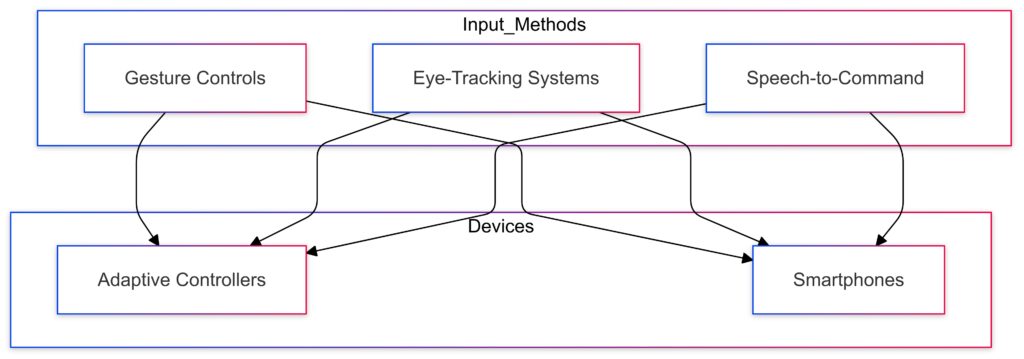
The gaming world has become a cultural powerhouse, but for disabled gamers, it often feels like an exclusive club. Enter artificial intelligence (AI), a game-changing ally in breaking barriers and building more inclusive experiences.
Let’s explore how AI is reshaping gaming accessibility.
How AI is Changing the Game for Disabled Players
Adaptive Game Controls Empower Independence
For gamers with mobility challenges, adaptive controls are a revelation. AI customizes control schemes based on unique needs.
- Gesture recognition: AI-powered tools can interpret head movements or eye tracking for input.
- Speech-to-command: Voice commands are being fine-tuned by AI to make complex games playable hands-free.
This tech isn’t limited to consoles. Mobile gaming has also seen a boom in AI-assisted interfaces, offering broader accessibility.

Dynamic Difficulty Adjustment Creates Fair Play
Not everyone can react at lightning speed, but AI ensures everyone enjoys the journey.
- AI tracks player performance, adjusting difficulty levels dynamically.
- It can offer hints or slow down gameplay when it senses a struggle.
Games like The Last of Us Part II showcase AI-driven features like enhanced audio cues, creating an equal playing field for all.

Audio Innovations for the Visually Impaired
For gamers with visual impairments, immersive audio can be a lifeline. AI enhances this experience in groundbreaking ways.
- 3D spatial audio helps players “see” through sound.
- AI learns gameplay patterns, offering real-time verbal feedback.
By creating rich soundscapes, games allow visually impaired players to navigate, strategize, and compete like never before.
Personalized Gaming Experiences
AI excels in crafting personalized experiences that cater to a variety of disabilities.
- Customized avatars tailored to physical or sensory limitations.
- Interfaces simplified by AI to reduce cognitive overload.
This adaptability allows for greater inclusion without sacrificing game complexity or fun.

Bridging the Communication Gap in Multiplayer
Communication is the heartbeat of multiplayer games. AI tools, like real-time captioning, empower deaf players to fully engage.
- AI generates captions for in-game audio, from voice chat to sound effects.
- Real-time speech-to-text creates seamless communication across teammates.
With these tools, players who were once sidelined are now part of the conversation.
The Role of AI in Accessibility Testing

Proactively Identifying Barriers
AI-driven accessibility testing tools simulate diverse disabilities to identify pain points early.
- Simulations include testing for low vision or reduced motor skills.
- AI analyzes gameplay metrics to pinpoint frustrating elements for disabled users.
This ensures games launch with inclusivity baked in, not as an afterthought.
Automating Bug Fixes
Accessibility bugs can be costly and time-consuming to address. AI steps in to streamline fixes.
- Machine learning algorithms flag inconsistencies in controls or interfaces.
- Developers can prioritize updates based on user impact.
This proactive approach keeps games evolving to meet diverse needs.
Building Inclusive Game Narratives
Accessibility isn’t just about mechanics. AI also supports storytelling that resonates with disabled gamers.
- Character creation engines powered by AI offer diverse representations.
- AI tools ensure narratives are culturally sensitive and inclusive of disabilities.
By aligning gameplay with players’ identities, developers foster deeper connections.
Collaborating with Disabled Gamers
Co-Creation Through AI
AI tools facilitate collaboration between developers and the disabled gaming community.
- Developers use AI to analyze feedback from accessibility consultants.
- Community-designed mods powered by AI enhance functionality and usability.
This partnership helps build games that reflect real-world needs.
Crowdsourced Innovation
AI-powered platforms connect disabled gamers to share ideas and solutions.
- Gamers test prototypes in real-time, providing invaluable insights.
- AI aggregates feedback, spotting patterns that drive meaningful change.
Through crowdsourcing, the gaming industry stays accountable and inclusive.
AI Innovations in Hardware Accessibility
Smart Controllers Adapt to Unique Needs
AI-driven smart controllers are redefining how hardware serves disabled gamers.
- Pressure sensitivity adjustments for players with reduced grip strength.
- AI learning patterns to adapt button mapping based on gameplay style.
Microsoft’s Adaptive Controller and similar devices are continually evolving thanks to AI, opening doors to gamers who once struggled with traditional setups.
Wearable Tech Integrates Seamlessly
Wearables, powered by AI, are transforming accessibility.
- Brain-computer interfaces (BCIs) let players control games with thoughts.
- AI-enabled gloves and sensors translate subtle gestures into in-game actions.
These technologies go beyond gaming, improving quality of life for users in other areas as well.
Voice Recognition Breaks Barriers
For gamers with mobility limitations, voice recognition AI transforms commands into fluid gameplay.
- AI improves response accuracy over time through machine learning.
- It supports multiple languages and accents, making it more inclusive globally.
This allows gamers to fully immerse themselves without relying on complex physical inputs.
AI and Game Development Accessibility Standards

Setting Industry Benchmarks
AI helps developers adhere to accessibility standards with precision.
- Tools like Unity Accessibility Plugin leverage AI to detect issues in early builds.
- Game engines integrate AI scripts that guide compliance with standards like WCAG.
By automating these processes, studios can focus on creativity without neglecting inclusivity.
Scaling Accessibility Across Genres
Whether it’s an intense RPG or a casual puzzle game, AI ensures accessibility isn’t genre-specific.
- AI analyzes genre-specific needs to tailor solutions.
- Puzzle games may use visual contrast aids, while RPGs focus on flexible narratives.
This ensures no gamer feels excluded, regardless of their preferences.
Predicting Future Needs
AI doesn’t just solve today’s problems; it anticipates tomorrow’s.
- Predictive algorithms analyze demographic data to foresee emerging accessibility challenges.
- Developers can adapt games to evolving player needs, staying ahead of the curve.
This proactive approach keeps gaming relevant and inclusive as technologies and disabilities change.
Challenges in AI-Powered Accessibility
Balancing Cost and Innovation
AI-driven tools aren’t cheap, and smaller studios face hurdles integrating them.
- High costs of AI development can limit widespread adoption.
- Open-source AI projects offer a cost-effective alternative for indie developers.
Balancing innovation with affordability is critical to leveling the playing field for all developers.
Avoiding Overreliance on AI
While AI is transformative, overreliance can lead to cookie-cutter solutions.
- Human input remains vital for understanding emotional nuances.
- Disabled gamers must be involved in testing to ensure solutions feel authentic.
AI is an ally, not a replacement, for thoughtful and inclusive game design.
Privacy Concerns in Data Collection
AI thrives on data, but collecting it raises privacy concerns.
- Tracking gameplay behavior for accessibility can feel invasive.
- Transparent data policies are essential to build trust with users.
Striking a balance between personalization and privacy is key to AI’s success in gaming accessibility.
The Future of Accessible Gaming

AI and Virtual Reality (VR)
Virtual reality is fertile ground for accessibility innovation. AI is unlocking VR experiences for all.
- AI adjusts VR environments to minimize motion sickness or sensory overload.
- Tools like haptic feedback devices enable tactile gameplay for the visually impaired.
As VR evolves, so will the AI solutions that power it, making virtual worlds accessible to everyone.
Global Accessibility Initiatives
AI is playing a role in shaping global standards for accessible gaming.
- Collaboration between studios, advocacy groups, and AI developers is driving change.
- Emerging markets are leveraging AI to design culturally inclusive accessibility features.
The result? A gaming landscape where inclusivity isn’t just a perk—it’s the norm.
Building a More Inclusive Culture
Ultimately, AI is about more than just technology; it’s fostering a culture where everyone belongs.
- By normalizing accessibility, developers are setting a precedent for other industries.
- Disabled gamers are becoming more visible, their voices driving innovation.
As this culture grows, gaming will no longer be a privilege—it will truly be for everyone.
AI-Powered Procedural Generation for Accessibility
Customizable Game Environments
AI procedural generation doesn’t just create levels; it creates accessible gameplay experiences.
- AI can auto-generate simplified level designs for players with cognitive impairments.
- Dynamic environment adjustments can reduce visual clutter or adjust brightness for better visibility.
This feature allows gamers to tailor their experiences, ensuring the fun never feels out of reach.
Personalized Tutorials
Learning curves can be steep for some players, but AI is making onboarding easier.
- AI analyzes player progress to deliver real-time, tailored tutorials.
- It simplifies explanations without dumbing down mechanics, ensuring accessibility for all.
This not only enhances engagement but also ensures no player feels overwhelmed.
Evolving AI for Emotional Accessibility
Managing Emotional Challenges
For gamers with anxiety or PTSD, AI creates emotionally supportive environments.
- Content warnings powered by AI notify players of potentially triggering scenarios.
- Adaptive systems adjust the intensity of challenging or violent game moments.
This level of customization promotes a safe, enjoyable experience for players who may have avoided gaming altogether.
Enhancing Social Inclusion
Multiplayer games can feel isolating for those with communication challenges, but AI bridges the gap.
- AI tools interpret non-verbal cues like gestures or body language in VR.
- Advanced sentiment analysis fosters positive, inclusive interactions by moderating chatrooms in real time.
This makes online gaming spaces welcoming and respectful for all players.
AI’s Role in Gamification of Accessibility
Learning and Skill Development
AI is blending gaming and education to teach new skills to disabled players.
- Games designed with cognitive rehabilitation tools improve memory, focus, and problem-solving.
- AI adjusts game mechanics to make learning seamless, creating entertainment with purpose.
These tools go beyond gaming, aiding disabled players in their daily lives.
Pioneering Accessible eSports
The competitive gaming space, or eSports, is being redefined with AI.
- AI tools enable disabled players to compete professionally by automating challenging inputs.
- Teams and tournaments are adopting AI-driven accessibility standards, broadening participation.
The future of eSports will see a diverse pool of talent, with AI leveling the playing field.
AI in Gaming Accessibility Beyond Entertainment
Therapeutic Applications
Gaming often transcends fun, offering therapeutic benefits for disabled players.
- AI-assisted games are being used in physical therapy, helping players rebuild motor skills.
- For those with mental health challenges, AI-curated games provide a safe escape or meditative experience.
Developers are finding ways to align gaming accessibility with healthcare innovation.
Career Opportunities in Game Design
Disabled gamers bring unique perspectives to game design, and AI helps amplify their contributions.
- AI-driven design tools simplify game creation, allowing disabled creators to innovate without barriers.
- Training programs incorporate AI to teach coding and design, enabling career pathways in the gaming industry.
By empowering disabled gamers to become developers, the industry becomes more inclusive at every level.
Takeaway: AI’s potential in gaming accessibility goes beyond mechanics—it’s shaping a world where disabled gamers are empowered as players, creators, and even competitors. The future of gaming is brighter, more inclusive, and undeniably exciting. The only limit? How far we’re willing to go to ensure no one is left behind.
FAQs
Are there AI-driven tools to assist players with cognitive impairments?
Yes! AI helps simplify interfaces and gameplay for those with cognitive challenges. Games like Minecraft: Education Edition use AI to adapt complexity levels, breaking tasks into manageable steps. AI-driven tutorials provide real-time guidance, ensuring players never feel lost or overwhelmed. Such features make even intricate games accessible to all skill levels.
Can AI improve gaming experiences for players with anxiety or PTSD?
Definitely. AI creates emotionally supportive gameplay by identifying triggers and offering adaptive difficulty. For example, in story-driven games like Celeste, AI can adjust tense moments to reduce stress or provide calming music. These systems help players engage at their own comfort levels, turning gaming into a safe, enjoyable escape.
Is AI helping game developers prioritize accessibility from the start?
Yes, AI tools like the Unity Accessibility Plugin help developers design inclusive games from the outset. These tools simulate disabilities—such as low vision or limited mobility—to identify potential barriers early. For example, Forza Horizon 5 included AI-backed accessibility testing during development, resulting in a game that embraced diverse player needs from day one.
How does AI ensure accessibility in virtual reality (VR)?
AI enhances VR accessibility by tailoring virtual environments to individual needs. In games like Beat Saber, AI adjusts features like motion sensitivity to prevent nausea. Haptic feedback systems further assist visually impaired players by providing tactile cues during gameplay. These innovations ensure immersive VR experiences are accessible to all.
Are there affordable AI solutions for smaller game studios?
Yes, open-source AI tools are enabling indie developers to embrace accessibility. Projects like OpenAI’s APIs or Google’s TensorFlow provide scalable solutions for features like voice recognition and adaptive difficulty. Indie games like Celeste have shown how even small teams can leverage affordable tools to make accessibility a priority.
Can AI-powered games aid in rehabilitation?
Yes, AI-powered games are used in rehabilitation to improve motor skills and cognitive functions. For example, games designed for stroke recovery use AI to adjust challenges based on patient progress. VR platforms powered by AI are also helping users regain mobility through engaging, therapeutic exercises.
How does AI assist gamers with hearing impairments?
AI enhances accessibility for deaf or hard-of-hearing gamers by providing real-time captioning and visual cues. Games like Overwatch use AI to convert audio cues into visual signals, such as directional indicators for enemy sounds. Advanced AI systems also generate real-time text transcriptions of in-game dialogue, allowing players to stay fully engaged with the story and teammates.
Can AI help create games specifically designed for disabled players?
Yes, AI enables the creation of games tailored to specific disabilities. For instance, audio-based games like Blind Legend cater to visually impaired players by using AI-enhanced 3D audio to guide them through challenges. Additionally, game engines powered by AI allow developers to quickly prototype and adapt mechanics to meet diverse accessibility needs, paving the way for more inclusive game genres.
How does AI personalize gaming experiences for individual disabilities?
AI analyzes player behavior and adapts gameplay to fit their needs. For example, in games like Assassin’s Creed: Valhalla, colorblind modes powered by AI adjust colors dynamically. Similarly, adaptive AI can reduce button-mashing sequences for players with motor impairments, ensuring no one feels excluded from critical gameplay moments.
Is AI helping improve accessibility in mobile gaming?
Yes, mobile gaming has seen significant advances in accessibility thanks to AI. Features like gesture controls and voice commands are integrated into games like Clash of Clans. AI also enables dynamic text resizing and screen readers for visually impaired users. These innovations make mobile games more inclusive, reaching a wider audience.
How is AI making eSports accessible for disabled gamers?
AI-driven solutions are opening eSports to disabled players by leveling the competitive field. Tools like speech-to-command interfaces let players control complex strategies without manual inputs. AI also powers auto-adjusting controls to match different skill levels, enabling players with disabilities to compete in tournaments like League of Legends. This fosters inclusivity in one of gaming’s most competitive spaces.
Can AI address accessibility for mental health challenges?
Absolutely. AI systems are being used to create gaming environments that promote mental well-being. For example, in games like Journey, AI dynamically adjusts the atmosphere, including soundscapes and visuals, to reduce stress. Mental health-focused games powered by AI offer mindfulness exercises and custom pacing, helping players manage anxiety or focus issues while enjoying the experience.
Are there examples of AI helping disabled gamers in augmented reality (AR)?
Yes, AI in AR enables players with disabilities to engage with their surroundings more interactively. For example, in AR games like Pokémon GO, AI provides vibration feedback for visually impaired players when Pokémon are nearby. AI-driven tools can also simplify augmented interfaces by prioritizing critical elements, making AR experiences more accessible to all users.
How is AI improving inclusivity in game narratives?
AI ensures game narratives reflect diverse experiences by enabling dynamic storytelling. For example, games like Cyberpunk 2077 use AI to create characters with customizable attributes, including disabilities. This helps players see themselves represented. Additionally, AI analyzes cultural and social contexts to avoid stereotypes, crafting stories that resonate with a wide range of players.
Can AI support gamers with progressive disabilities?
AI’s adaptability makes it ideal for players with progressive conditions. As needs evolve, AI can automatically adjust settings like control sensitivity or gameplay speed. For instance, games like Stardew Valley can be played with customizable inputs, ensuring a seamless experience as physical capabilities change.
What about the role of AI in cooperative or family gaming for players with disabilities?
AI bridges skill gaps in cooperative or family gaming by dynamically adapting gameplay to different abilities. In games like Mario Kart, AI-assisted steering helps younger or disabled players stay competitive without feeling left behind. Similarly, AI ensures multiplayer modes remain enjoyable for all participants, encouraging inclusive family bonding through gaming.
Is AI addressing accessibility in story-driven games?
Yes, AI enhances story-driven games by tailoring the narrative experience to individual needs. For example, in Detroit: Become Human, AI dynamically adjusts the difficulty of decision-making or time-sensitive choices for players with cognitive impairments. It can also summarize previous events or provide contextual hints, ensuring players stay connected to the story without frustration.
How is AI used in open-world games for accessibility?
AI in open-world games creates navigation aids for players with disabilities. For instance, in The Witcher 3, AI-powered GPS-like systems help guide players with visual or cognitive impairments to their objectives. Fast travel systems optimized by AI allow players to skip challenging terrain or combat, making exploration accessible without diminishing the game’s depth.
Can AI assist with training for disabled gamers?
Yes, AI supports training by analyzing gameplay patterns and offering personalized coaching. Games like League of Legends use AI to suggest strategic moves, helping players with cognitive or physical challenges improve. Training programs powered by AI can also simulate specific scenarios to teach techniques or enhance reaction times, preparing disabled gamers for competitive or advanced play.
How does AI make game streaming more inclusive?
AI improves accessibility in streaming by offering real-time captioning for deaf viewers and audio descriptions for blind audiences. Platforms like Twitch use AI to transcribe live chats and narrate visual gameplay cues. This ensures disabled gamers can engage with streaming communities as both creators and audiences.
Can AI enhance tabletop games translated into digital formats?
Absolutely. AI has made digital adaptations of tabletop games like Dungeons & Dragons accessible to disabled players. For example, AI-driven voice narrators read game lore, while automated dice rolling assists players with mobility challenges. Additionally, AI adapts rule complexity in real time, making these games enjoyable for everyone regardless of physical or cognitive ability.
Resources
Organizations Driving Accessibility in Gaming
- AbleGamers Charity: A non-profit that advocates for gaming accessibility, offering resources and grants to help developers create inclusive games. Visit their official website.
- SpecialEffect: A UK-based organization that uses technology like adaptive controllers and eye-tracking systems to help disabled players. Learn more at SpecialEffect.
- IGDA Accessibility SIG: The International Game Developers Association (IGDA) Accessibility Special Interest Group provides guidelines and research to improve gaming accessibility. Check out their resources.
Accessible Gaming Tools and AI Solutions
- Microsoft Adaptive Controller: A revolutionary controller designed for gamers with limited mobility. Learn more at Microsoft Adaptive Controller.
- Unity Accessibility Plugin: A plugin that helps developers integrate accessibility features directly into Unity games. Explore it on Unity Asset Store.
- Google AI Accessibility Tools: Google’s AI offers open-source tools like speech-to-text and object recognition, which can be integrated into games. Check out Google AI Resources.
Online Learning and Tutorials
- Game Accessibility Guidelines: A comprehensive guide for developers to create accessible games, including AI-driven solutions. Visit Game Accessibility Guidelines.
- Coursera: AI in Accessibility: Courses on AI applications, including accessibility in gaming and beyond. Start learning at Coursera.
- YouTube Channels: Channels like Mark Brown’s Game Maker’s Toolkit explore accessibility in gaming, often featuring AI innovations. Watch at Game Maker’s Toolkit.
AI Accessibility Research and Innovations
- Microsoft Research: AI for Accessibility: Research papers and projects focused on leveraging AI for accessible technology. Dive into their work at Microsoft Research.
- SIGGRAPH Accessibility Papers: Publications on cutting-edge technology, including AI applications in gaming. Find relevant papers on ACM Digital Library.
- AI4Bharat: Focused on AI accessibility innovations, including for underserved and disabled communities. Learn more at AI4Bharat.
Communities and Forums
- Reddit – r/DisabledGamers: A subreddit where disabled gamers share experiences, tips, and accessible game recommendations. Join the discussion at r/DisabledGamers.
- Accessible.Games Discord Server: A community for developers and gamers to collaborate on accessibility-focused projects. Look for invites on forums like AbleGamers.
- Gaming Accessibility Slack: A space for developers and advocates to discuss inclusive gaming. Request access via the IGDA Accessibility SIG website.